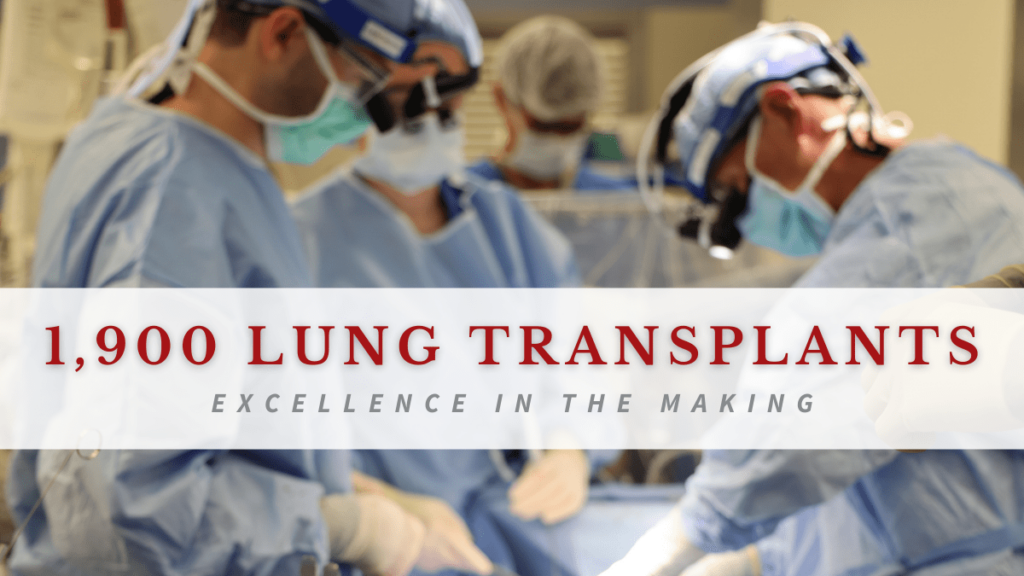The Lung Transplant Program at Washington University School of Medicine in St. Louis has performed 1,900 lung transplants since its establishment over three decades ago. One of the oldest and most experienced programs in the world, the Lung Transplant Program has some of the best outcomes in the United States and wait times lower than the national average. As part of the Lung Center at Barnes-Jewish Hospital, the program is ranked among the best in the country by U.S. News & World Report.
In recent years, the program has excelled and reached new milestones of clinical activity under the leadership of Surgical Program Director Daniel Kreisel, MD, PhD, and Medical Program Director Ramsey Hachem, MD.
“Our team is highly collaborative,” says Kreisel, the Section Chief of Cardiothoracic Transplantation. “Our thoracic surgeons and colleagues in pulmonary medicine work closely together to achieve the best outcomes for our patients.”
The multidisciplinary team, which also includes transplant coordinators, transplant pharmacists, respiratory therapists, dieticians, social workers and financial coordinators, has established partnerships to deliver world-class care for lung transplant recipients at every stage of the process.
“The internal partnerships established within Washington University School of Medicine consistently allow patients to receive genuine tailored care,” says Hachem, the Tracey C. Marshall – Dr. Elbert P. Trulock Distinguished Professor of Medicine in the Division of Pulmonary and Critical Care Medicine.
Lung transplant faculty are leaders in innovation, advancing the field through collaborative basic science and translational research. As Scientific Director of the Transplant Center, Kreisel led Washington University researchers to discover new clues as to why lung transplants are vulnerable to antibody-mediated rejection, a condition that leads to death for many lung transplant recipients. They discovered a mechanism, in mice, that may prevent the rejection and possible therapies to treat the condition. In addition, junior faculty members in Surgery and Pulmonary Medicine have initiated their own research efforts related to lung transplantation and have been successful in obtaining extramural funding.
“The Lung Transplant Program has also made significant strides in optimizing the evaluation and management of lung donors, a critical step in ensuring good clinical outcomes,” says Varun Puri, MD, MSCI, Associate Surgical Director and Professor of Surgery. Puri is currently supported by an NIH grant to design optimal donor care pathways and leads a collaborative effort involving multiple organ procurement organizations nationwide.
“Dr. Kreisel is very highly regarded for his surgical skills in organ transplantation and for his research involving immunological mechanisms of transplant rejections,” says David H. Perlmutter, MD, executive vice chancellor for medical affairs and the George and Carol Bauer Dean of the School of Medicine. “His determination to improve outcomes for patients drives his work and will continue to have profound impact for transplant patients.”
Kreisel is currently principal investigator of three grants from the National Institutes of Health to study the prevention of organ rejection after transplantation.
“What differentiates the Lung Transplant Program at Washington University and Barnes-Jewish Hospital is that we combine excellence in clinical care, high clinical volume, and innovation in basic and translational research,” says Kreisel, who is also the inaugural G. Alexander Patterson MD/Mid-America Transplant Endowed Distinguished Chair in Lung Transplantation. While celebrating the landmark achievement of 1,900 lung transplants, the program continues to innovate and advance medicine to provide leading care for lung transplant recipients. Looking to the future, Kreisel envisions that lung transplantation will deliver improved outcomes through personalized care. “My vision is that within the next five years we will have personalized medicine for each lung transplant recipient that accounts for their unique characteristics.”
